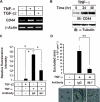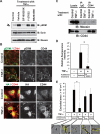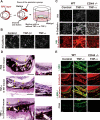Tumor necrosis factor-alpha regulates transforming growth factor-beta-dependent epithelial-mesenchymal transition by promoting hyaluronan-CD44-moesin interaction
- PMID: 19965872
- PMCID: PMC2823547
- DOI: 10.1074/jbc.M109.056523
Tumor necrosis factor-alpha regulates transforming growth factor-beta-dependent epithelial-mesenchymal transition by promoting hyaluronan-CD44-moesin interaction
Abstract
Aberrant epithelial-mesenchymal transition (EMT) is involved in development of fibrotic disorders and cancer invasion. Alterations of cell-extracellular matrix interaction also contribute to those pathological conditions. However, the functional interplay between EMT and cell-extracellular matrix interactions remains poorly understood. We now show that the inflammatory mediator tumor necrosis factor-alpha (TNF-alpha) induces the formation of fibrotic foci by cultured retinal pigment epithelial cells through activation of transforming growth factor-beta (TGF-beta) signaling in a manner dependent on hyaluronan-CD44-moesin interaction. TNF-alpha promoted CD44 expression and moesin phosphorylation by protein kinase C, leading to the pericellular interaction of hyaluronan and CD44. Formation of the hyaluronan-CD44-moesin complex resulted in both cell-cell dissociation and increased cellular motility through actin remodeling. Furthermore, this complex was found to be associated with TGF-beta receptor II and clathrin at actin microdomains, leading to activation of TGF-beta signaling. We established an in vivo model of TNF-alpha-induced fibrosis in the mouse eye, and such ocular fibrosis was attenuated in CD44-null mice. The production of hyaluronan and its interaction with CD44, thus, play an essential role in TNF-alpha-induced EMT and are potential therapeutic targets in fibrotic disorders.
Figures








Similar articles
-
Hyaluronan promotes signaling interaction between CD44 and the transforming growth factor beta receptor I in metastatic breast tumor cells.J Biol Chem. 2002 Oct 18;277(42):39703-12. doi: 10.1074/jbc.M204320200. Epub 2002 Jul 26. J Biol Chem. 2002. PMID: 12145287
-
Epigenetic regulation of the epithelial mesenchymal transition induced by synergistic action of TNF-α and TGF-β in retinal pigment epithelial cells.Biochem Biophys Res Commun. 2021 Mar 12;544:31-37. doi: 10.1016/j.bbrc.2021.01.060. Epub 2021 Jan 28. Biochem Biophys Res Commun. 2021. PMID: 33516879
-
Aging fibroblasts resist phenotypic maturation because of impaired hyaluronan-dependent CD44/epidermal growth factor receptor signaling.Am J Pathol. 2010 Mar;176(3):1215-28. doi: 10.2353/ajpath.2010.090802. Epub 2010 Jan 21. Am J Pathol. 2010. PMID: 20093489 Free PMC article.
-
Blockade of Jagged/Notch pathway abrogates transforming growth factor β2-induced epithelial-mesenchymal transition in human retinal pigment epithelium cells.Curr Mol Med. 2014 May;14(4):523-34. doi: 10.2174/1566524014666140331230411. Curr Mol Med. 2014. PMID: 24694299 Review.
-
Involvement of hyaluronan and CD44 in cancer and viral infections.Cell Signal. 2020 Jan;65:109427. doi: 10.1016/j.cellsig.2019.109427. Epub 2019 Oct 22. Cell Signal. 2020. PMID: 31654718 Review.
Cited by
-
CD44S-hyaluronan interactions protect cells resulting from EMT against anoikis.Matrix Biol. 2015 Oct;48:55-65. doi: 10.1016/j.matbio.2015.04.010. Epub 2015 Apr 30. Matrix Biol. 2015. PMID: 25937513 Free PMC article.
-
Efficient TGFβ-induced epithelial-mesenchymal transition depends on hyaluronan synthase HAS2.Oncogene. 2013 Sep 12;32(37):4355-65. doi: 10.1038/onc.2012.475. Epub 2012 Oct 29. Oncogene. 2013. PMID: 23108409 Free PMC article.
-
Hyaluronic acid promotes angiogenesis by inducing RHAMM-TGFβ receptor interaction via CD44-PKCδ.Mol Cells. 2012 Jun;33(6):563-74. doi: 10.1007/s10059-012-2294-1. Epub 2012 May 18. Mol Cells. 2012. PMID: 22610405 Free PMC article.
-
Microarray analysis of gene expression in West Nile virus-infected human retinal pigment epithelium.Mol Vis. 2012;18:730-43. Epub 2012 Mar 27. Mol Vis. 2012. PMID: 22509103 Free PMC article.
-
Molecular mechanisms of subretinal fibrosis in age-related macular degeneration.Exp Eye Res. 2016 Jan;142:19-25. doi: 10.1016/j.exer.2015.03.009. Epub 2015 Mar 13. Exp Eye Res. 2016. PMID: 25773985 Free PMC article. Review.
References
-
- Thiery J. P. (2002) Nat. Rev. Cancer 2, 442–454 - PubMed
Publication types
MeSH terms
Substances
Associated data
- Actions
LinkOut - more resources
Full Text Sources
Other Literature Sources
Molecular Biology Databases
Research Materials
Miscellaneous

